Abstract
Simple Summary
The present study describes a new genus, Cerogamasus gen. nov., and four new species, Cerogamasus tibetensis Jin & Yao sp. nov., Cerogamasus anhuiensis Jin & Yao sp. nov., Cerogamasus guizhouensis Jin & Yao sp. nov. and Cerogamasus multidentatus Jin & Yao sp. nov. Cycetogamasus coreanus Athias-Henriot, 1980, is transferred from the genus Cycetogamasus to Cerogamasus gen. nov. An identification key to the known species of new genus is provided.
Abstract
The new genus, Cerogamasus gen. nov., with the type species Cerogamasus tibetensis sp. nov., is established. The new genus is easily distinguished from other genera of Parasitidae because the dorsal idiosoma in both sexes bears more than 40 pairs of setae, of which fewer than 7 pairs of podonotal setae are smooth; the seta z5 of the dorsal hexagon is similar to j5 and j6 in form (pilose or distally pilose) while different in length (z5 longer); the seta al of the palpfemur is pectinate, and al1 and al2 of the palpgenu are entire; the gnathotectum is trispinate; peritrematal shields in females are posteriorly free; and the palptrochanter in males has a pointed ventral protuberance. C. anhuiensis sp. nov., C. guizhouensis sp. nov. and C. multidentatus sp. nov. are described based on adult samples; C. tibetensis sp. nov. is described based on deutonymph and adult samples. Cycetogamasus coreanus Athias-Henriot, 1980, is transferred to Cerogamasus gen. nov. as a new combination.
1. Introduction
The Mesostigmata is a large mite order corresponding to about 20% of all known mite species []. The family Parasitidae Oudemans, 1901, is among the most common and widely distributed families of Mesostigmata [,]. The mites of the family occur in soil and decaying organic material such as manure, debris and compost; some species are found on the body surface of birds or arthropods and in carcasses of mammals [,,]. They are essentially predatory and feed upon other microarthropods and nematodes, including their eggs [,]. Parasitidae comprises more than 500 species and 46 genera in two subfamilies: Parasitinae Oudemans, 1901 (23 genera), and Pergamasinae Juvara-Bals, 1972 (23 genera) [,,,].
In a study of Parasitidae by Chinese scholars first reported in 1963, Jiang et al. [] discovered Poecilochirus necrophori Vitzthum, 1930, and P. subterraneus Miiller, 1860, on the body surface of mice. In the following 30 years, the study of Parasitidae in China was slow; 22 species were reported [,,,]. Since the 1990s, many scholars have carried out surveys of Parasitidae in the Chinese fauna, and a large number of new species and new record species of Parasitidae have been discovered and reported [,,,,,,,,,,,]. The known Chinese fauna of Parasitidae has now grown to more than 150 species, nearly two-thirds of which have been reported only in China [].
Four new species were found during a current study of the Chinese Parasitidae. According to the key for the families of the order Mesostigmata [] as well as the definitions provided by Evans and Till [] and Hrúzová and Fenďa [], we have placed them in the subfamily Parasitinae. The aim of this study is to describe a new genus, Cerogamasus, and four new species, C. tibetensis, C. anhuiensis, C. guizhouensis and C. multidentatus, of Parasitidae from China and thus contribute to the knowledge of the fauna of Mesostigmata in Asia.
2. Materials and Methods
Individuals of four new species were extracted from decaying leaves, moss, weed piles or rotten wood from Berlese–Tullgren funnels for 12–24 h; placed in 75% alcohol; cleaned in Nesbitt’s solution; and then mounted on slides in Hoyer’s medium (distilled water/arabic gum/chloral hydrate = 5:3:20:2) for later identification []. All specimens were deposited in the Institute of Entomology, Guizhou University, Guiyang, China (GUGC).
Line drawings were prepared with the aid of a drawing tube attached to a phase-contrast Nikon Ni E microscope with DIC optics; photographs were taken using a camera (Nikon DS-Ri 2) attached to a Nikon Ni E microscope with DIC optics and figures were edited with Adobe Photoshop CC 2021. Measurements were carried out on all available specimens, the measuring followed that in [] and all measurements were given in micrometres (μm).
The system of idiosomal setal nomenclature followed []. Terminology for the palp chaetotaxy followed [], and then adenotaxy (idiosomal glands) and poroidotaxy (lyrifissures) followed [,]. The description of the males and deutonymphs omitted the features common with the females.
3. Results
- Family Parasitidae Oudemans, 1901;
- Subfamily Parasitinae Oudemans, 1901;
- Genus Cerogamasus Jin & Yao gen. nov.;
- Type species Cerogamasus tibetensis Jin & Yao sp. nov.
The diagnosis of Cerogamasus gen. nov. in both sexes: dorsal idiosoma well sclerotized and reticulated, bearing more than 40 pairs of setae, of which fewer than seven pairs of podonotal setae are smooth; seta z5 of the dorsal hexagon similar to j5 and j6 in form (pilose or distally pilose), but different in length (z5 longer); seta al of palpfemur pectinate and al1 and al2 of palpgenu entire; corniculi short; gnathotectum three prongs (but four prongs in the male of C. multidentatus sp. nov.); fixed digits of chelicera with more than seven teeth.
In the female: podonotal and opisthonotal shields separate; metasternal shield separated from sternal and epigynal shields; epigynal shield subtriangular and separated from opisthogastric shield; opisthogastric shield bearing at most ten pairs of ventral setae; peritrematal shields posteriorly free; movable digits of chelicerae with more than seven teeth.
In the male: Holodorsal shield with a transverse suture in central region; the base of tritosternum reduced; the venter of hypostome elevated forward and forming a protuberance; setae h1, h2 and h3 on the protuberance, seta pcx near the base; palptrochanter with a pointed and horn-like ventral protuberance. Femur II with a main spur (proximal) and an axillary process (distally), genu II with or without spur, and tibia II with a spur.
Etymology. The name of the genus is derived from “cero–“, meaning “horn”, and refers to the horn-like process on the palp trochanter in males, with “–gamasus” referring to gamasine mites (masculine).
Differential diagnosis: The taxonomy of Parasitidae is based on some key morphological charactistics to separate genera. These include peritrematal shields of female posteriorly free or not; seta al on palpfemur entire or divided apically; both setae al1 and al2 on palpgenu entire or only one seta entire; metasternal shields of female detached from sternal and epigynal shield or fused; epigynal shield separated from opisthogastric shield or fused; male palptrochanter with or without ventral protuberance, venter of hypostome elevated forward and forming protuberance, or without; and genu II with or without a spur [,,,,,]. Considering these characteristics, Cerogamasus gen. nov. is similar to Trachygamasus Berlese, 1904; Psilogamasus Athias-Henriot, 1969; and Coprocarpais Hrúzová & Fenďa, 2018 [,,,].
Cerogamasus gen. nov. shares with Trachygamasus [,] the following characteristics: setae al1 and al2 on palpgenu entire, gnathotectum trifid, seta z5 pilose or distally pilose, male genu II with or without spur and venter of hypostome elevated forward and forming a protuberance. However, Cerogamasus gen. nov. is different from Trachygamasus as follows: (1) seta al on palpfemur pectinate, vs. entire in Trachygamasus; (2) dorsal setae j5 and j6 pilose or distally pilose, vs. smooth in Trachygamasus; (3) female peritrematal shields posteriorly free, vs. fused to ventral shield in Trachygamasus; (5) female opisthonotal shield with more than 15 pairs of pilose setae, vs. fewer than 5 pairs in Trachygamasus; (6) male palptrochanter with a pointed ventral protuberance, vs. without protuberance in Trachygamasus.
Cerogamasus gen. nov. shares with Psilogamasus [,] the following characteristics: setae al1 and al2 of palpgenu entire, seta al of palpfemur pectinate, female peritrematal shields free posteriorly, gnathotectum trifid. However, the new genus is different from Psilogamasus as follows: (1) setae z5, j5 and j6 pilose or distally pilose, vs. smooth in Psilogamasus; (2) presternal platelets well defined, vs. absent in Psilogamasus; (3) seta ZV1 present, vs. absent in Psilogamasus; (4) three prongs of gnathotectum pointed distally, vs. central prong apically with two to five branches or multidentate, lateral prongs spiculate with bifid apex or two to four apical branches in Psilogamasus; (5) podonotal shield of female with 22 pairs of setae, vs. 16–18 pairs in Psilogamasus; (6) opisthonotal shield with more than 20 pairs of setae, vs. 5–6 pairs in Psilogamasus; (7) male palptrochanter with one pointed ventral protuberance, vs. without protuberance in Psilogamasus.
Cerogamasus gen. nov. shares with Coprocarpais [] the following characteristics: setae al1 and al2 on palpgenu entire, gnathotectum trifid, seta z5 pilose or distally pilose, male palptrochanter with a big ventral protuberance. However, Cerogamasus gen. nov. is different from Coprocarpais as follows: (1) seta al on palpfemur pectinate, vs. entire in Coprocarpais; (2) dorsal setae z5, j5 and j6 pilose or distally pilose, vs. smooth in Coprocarpais; (3) female peritrematal shields posteriorly free, vs. fused to ventral shield in Coprocarpais; (4) podonotal shield of female with more than 12 pairs of pilose setae, vs. fewer than 5 pairs in Coprocarpais; (5) dorsal shields with flat reticulation, vs. distinct foveate sculpture in Coprocarpais; (6) male al1 and al2 acicular (button-shaped in C. multidentatus sp. nov.), vs. flat blades in Coprocarpais.
3.1. New Species
3.1.1. Cerogamasus tibetensis Jin & Yao sp. nov.
Diagnosis. Both sexes: dorsal setae z1, s1, s2, s6, r4, r5 and r6 smooth; gnathotectum emerging from nude base; seta pcx on gnathosoma smooth; setae v2 on palptrochanter stouter than v1. In the female, endogynium with an inverted V-shaped structure, each side of which is flanked with a reniform structure, and the rear with a saccate structure; opisthogastric shield bearing ten pairs of ventral setae, of which one pair thick and distally pilose. In the male, opisthogastric region with two pairs of distally pilose setae; movable digit with a blunt tooth; genu II and tibia II with a spur.
Type material. Holotype: ♀, encountered in moss on the wood, Bomi County (2624 m a.s.l., N 29°54′34″, E 95°29′37″), Linzhi, Tibet Autonomous Region, China, 17 July 2019. Paratypes: 1 ♀ and 1 deutonymph with the same details as holotype; 2 ♀♀ and 2 ♂♂ encountered in decaying leaves, Bomi County (2535 m a.s.l., N 29°56′44″, E 95°23′12″), Linzhi, Tibet Autonomous Region, China, 18 July 2019.
- Description
Female (n = 4). Dorsal idiosoma (Figure 1A). Idiosoma well sclerotized; length: 774–793; width: 561–588. Podonotal shield with 22 pairs of setae, of which setae z1, s1, s2, s6, r4, r5 are fine and smooth, others are thick and pilose. Lengths of setae on podonotal shield: j1 78–81, j2 94–96, j3 94–98, j4 97–100, j5 72–75, j6 65–68, z1 48–51, z2 65–68, z3 77–81, z4 82–86, z5 89–92, z6 54–56, s1 20–23, s2 14–15, s3 85–87, s4 86–89, s5 86–88, s6 35–37, r2 70–73, r3 161–167, r4 17–19, r5 24–27. Seta r6 is smooth and off the shield. Opisthonotal shield with 22 to 24 pairs of thicked and pilose setae, of which the setae R series is shorter than the J, Z and S series.
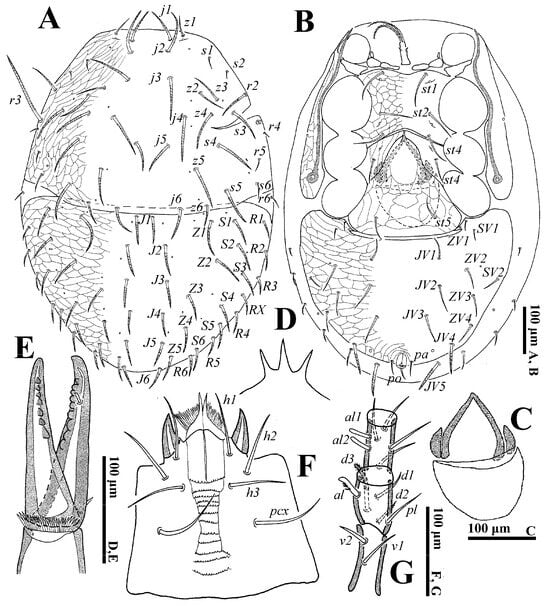
Figure 1.
Cerogamasus tibetensis Jin & Yao sp. nov., female. (A)—Dorsal idiosoma. (B)—Ventral idiosoma. (C)—Endogynium. (D)—Gnathotectum. (E)—Chelicera. (F)—Subcapitulum. (G)—Trochanter, femur and genu of palp.
Ventral idiosoma (Figure 1B). Tritosternum flanked by three pairs of presternal platelets close to each other. Sternal shield bearing three pairs of setae (st1–st3) and two pairs of poroids (iv1–iv2). Metasternal shield, bearing seta st4 and iv3, separated from sternal and epigynal shields. Gland pores gv2 not seen. Endogynium (Figure 1C) with an inverted V-shaped structure, its sides flanked with a reniform structure, and the rear with a saccate structure. Opisthogastric shield bearing ten pairs of ventral setae, seta JV4 thick and pilose. Opisthogastric soft cuticle with five pairs of setae, JV5 (70–72) pilose and longer than others. Peritrematal groove length 336–381. Lengths of setae on ventral shields: st1 72–75, st2 70–73, st3 65–68, st4 54–57, st5 54–55, JV1 44–46, JV2 57–59, JV3 55–57, JV4 63–65, ZV1 17–20, ZV2 43–45, ZV3 46–47, ZV4 41–43, SV1 19–21, SV2 36–38, pa 27–29, po 27–30.
Gnathosoma (Figure 1D–G). Gnathotectum with three prongs. Fixed and movable digits of chelicera with several small teeth. Deutosternal groove with 12 denticulate rows; setae h1 (79–81), h2 (73–75), h3 (68–70) and pcx (82–85) smooth. Palp length: 274–305; seta v2 on palptrochanter stouter than v1; seta al on palpfemur pectinate; d1 and d2 distally pilose; al1 and al2 on palpfemur spatulate, others simple.
Legs. Lengths of legs: I 796–919, II 649–666, III 553–612, IV 939–992. Leg II stouter than other legs. Setae av1, al1, pv1 and pl1 on tarsi II–IV modified to short and thick spurs. Most leg setae distally pilose (Figure 2).
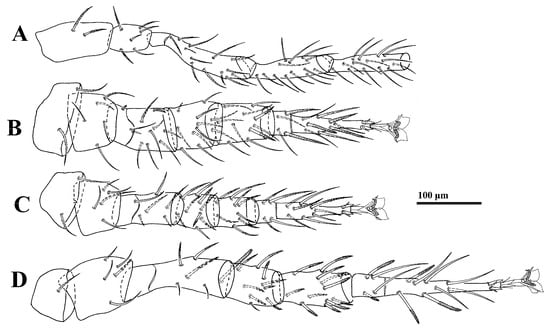
Figure 2.
Cerogamasus tibetensis Jin & Yao sp. nov., female. (A)—Coxa–tibia of leg I. (B)—Leg II. (C)—Leg III. (D)—Leg IV.
Male (n = 2). Dorsal idiosoma (Figure 3A). Idiosoma length: 715–757; width: 436–470. Holodorsal shield covering entire dorsum; a suture closely anterior to seta J1. All setae on the shield; setal form as in female.
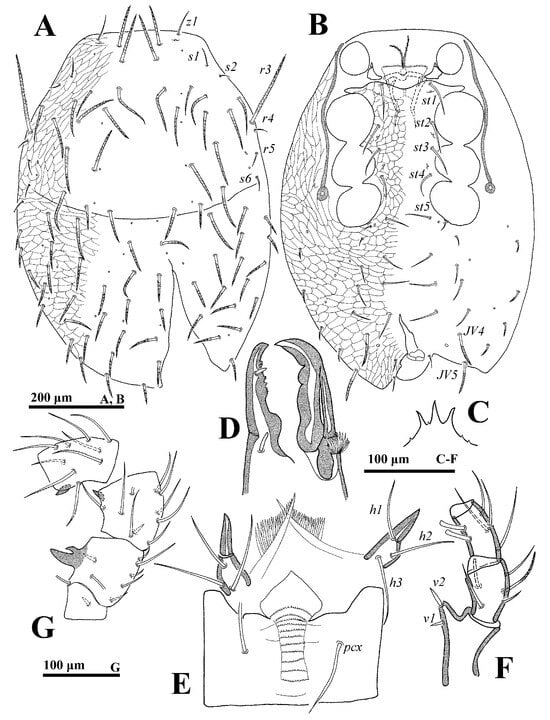
Figure 3.
Cerogamasus tibetensis Jin & Yao sp. nov., male. (A)—Dorsal idiosoma. (B)—Ventral idiosoma. (C)—Gnathotectum. (D)—Chelicera. (E)—Subcapitulum. (F)—Trochanter, femur and genu of palp. (G)—Femur, genu and tibia of leg II.
Ventral idiosoma (Figure 3B). Tritosternum base reduced. Genital opening flanked by one pair of presternal platelets, sometimes fragmented. Lengths of setae st1–st5 on sternogenital region: st1 67–70, st2 60–65, st3 52–56, st4 50–53, st5 50–52. Opisthogastric region with 14 pairs of setae, of which 6 pairs are distally pilose, JV4 (92–94) and JV5 (90–92), stouter and longer. Peritrematal groove length: 352–373.
Gnathosoma (Figure 3C–F). Palp length: 255–291; trochanter bearing seta v2 evidently stouter and longer than v1. Movable digit with a blunt tooth. Lengths of setae h1–h3 and pcx on hypostome: h1 55–58, h2 65–68, h3 72–75 and pcx 67–71.
Legs. Lengths of legs: I 824–893, II 612–676, III 544–591, IV 872–938. Femur II with a main spur (proximal) and an axillary process (distally); genu II and tibia II with a spur (Figure 3G).
Deutonymph (n = 1). Dorsal idiosoma (Figure 4A). Idiosoma weakly sclerotized; length: 710; width: 480. Podonotal and opisthonotal shields with 20 and 14 pairs of setae, respectively. Membranous cuticle of dorsal shields bearing 14 pairs of setae. Setae z1–z4, z6, s1–s3, s6, r2, r4–r6 fine and smooth, others distally pilose. Seta J1 absent. Lengths of setae on dorsal shields: j1 67, j2 68, j3 79, j4 91, j5 64, j6 59, z1 32, z2 55, z3 53, z4 77, z5 85, z6 39, s1 20, s3 60, s4 71, s5 75, s6 23, r2 48, r3 157, r5 19, J2 45, J3 41, J4 30, J5 44, Z1 72, Z2 48; Z3 41, J4 34, S1 31, S2 37, S3 31, S4 34.
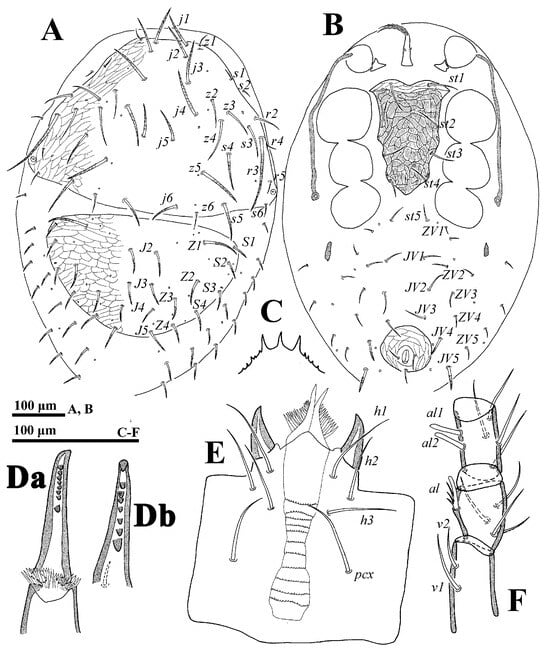
Figure 4.
Cerogamasus tibetensis Jin & Yao sp. nov., deutonymph. (A)—Dorsal idiosoma. (B)—Ventral idiosoma. (C)—Gnathotectum. (Da)—movable digit of chelicera; (Db)—fixed digit of chelicera. (E)—Subcapitulum. (F)—Trochanter, femur and genu of palp.
Ventral idiosoma (Figure 4B). Tritosternum flanked by a pair of irregular presternal platelets. Sternal shield reticulated with a pale anterior transverse strip, bearing four pairs of setae (st1–st4), of which setae st1 (55) and st2 (51) are longer than st3 (37) and st4 (34). Opisthogastric region with 15 pairs of setae and a pair of metapodal shields. Anal shield reticulated. Setae pa and po equal in length (29–30). Peritreme groove length: 291.
Gnathosoma (Figure 4C–F). Gnathotectum emerging from denticulate base. Deutosternal groove with 11 denticulate rows. Lengths of setae: h1 64, h2 52, h3 62 and pcx 64. Palp length: 267; seta v2 and v1 on trochanter equal in size.
Legs (Figure 5). Lengths of legs: I 773, II 553, III 524, IV 821. Setae av1, al1, pv1 and pl1 on tarsi II–IV fine and setiform.
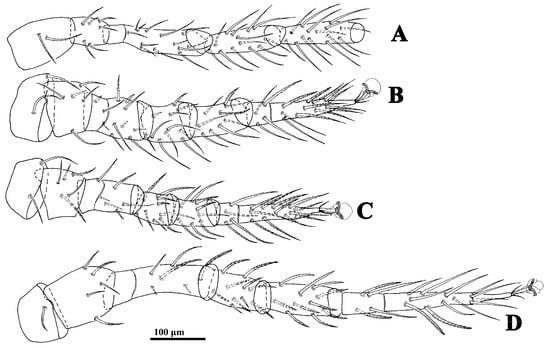
Figure 5.
Cerogamasus tibetensis Jin & Yao sp. nov., deutonymph. (A)—Coxa–tibia of leg I. (B)—Leg II. (C)—Leg III. (D)—Leg IV.
Other stages. Unknown.
Etymology. The new species name is derived from the type locality Tibet Autonomous Region, China (tibetensis).
Differential diagnosis. The female of C. tibetensis sp. nov. is morphologically similar to C. coreanus comb. nov. in the setal form on the subcapitulum and opisthonotal shields, the number of teeth on the cheliceral fixed digit and the endogynium reniform structure [,]. However, it differs from C. coreanus comb. nov. as follows: (1) opisthogastric shield bearing ten pairs of setae, vs. five pairs in C. coreanus comb. nov.; (2) seta v2 on palptrochanter smooth and stouter than v1, vs. distally pilose with setae v1 and v2 equal in size in C. coreanus comb. nov.; (3) deutosternal groove with 12 denticulate rows, vs. 8 rows in C. coreanus comb. nov.; (4) setae SV1 present, vs. absent in C. coreanus comb. nov.
3.1.2. Cerogamasus anhuiensis Jin & Yao sp. nov.
Type material. Holotype: ♀, encountered in decomposing leaves, Mount Huangshan Scenic Area (1785 m a.s.l., N 30°8′8″, E 118°9′38″), Huangshan, Anhui Province, China, 23 May 2018. Paratypes: four ♀♀ and three ♂♂ with the same details as holotype.
Diagnosis. Both sexes: dorsal setae z1, s1, s2, s6, r4, r5 and r6 smooth; gnathotectum emerging from denticulate base; seta pcx on gnathosoma pilose; setae v1 and v2 on palptrochanter equal in size. In females, endogynium with a saccate structure, its centre having two elliptic structures; opisthogastric shield bearing nine pairs of ventral setae, of which one pair of setae is distally pilose. In males, opisthogastric region with one distally pilose; movable digit with a blunt tooth; genu II without spur, tibia II with a spur.
- Description
Female (n = 5). Dorsal idiosoma (Figure 6A). Idiosoma well sclerotized; length: 742–756; width: 504–551. Podonotal and opisthonotal shields with reticulation. Podonotal shield bearing 22 pairs of setae, of which setae z1, s1, s2, s6, r4, r5 are fine and smooth, and others thick and pilose. Lengths of setae on podonotal shield: j1 72–75, j2 83–85, j3 91–95, j4 101–104, j5 63–65, j6 69–72, z1 52–55, z2 65–68, z3 84–86, z4 84–87, z5 83–85, z6 72–75, s1 28–31, s2 29–30, s3 81–83, s4 86–88, s5 88–90, s6 17–19, r2 81–84, r3 167–169, r4 19–21, r5 18–21. Seta r6 (18–21) smooth and off the shield. Opisthonotal shield bearing 20 pairs of thick and pilose setae, of which setae R serie (50–55) shorter than J (60–70), Z (61–85) and S (58–83) series.
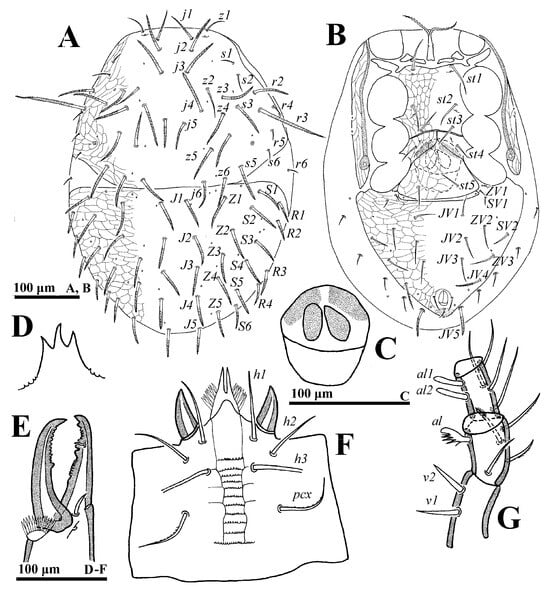
Figure 6.
Cerogamasus anhuiensis Jin & Yao sp. nov., female. (A)—Dorsal idiosoma. (B)—Ventral idiosoma. (C)—Endogynium. (D)—Gnathotectum. (E)—Chelicera. (F)—Subcapitulum. (G)—Trochanter, femur and genu of palp.
Ventral idiosoma (Figure 6B). Tritosternum flanked by two pairs of presternal platelets. Sternal setae st1 (65–67) longer than st2 (48–51) and st3 (52–54). Seta st4 length 44–46. Endogynium with a saccate structure, its centre having two elliptic structures (Figure 6C). Opisthogastric shield bearing nine pairs of ventral setae; seta JV4 thick and pilose. Opisthogastric soft cuticle with five pairs of setae; JV5 (48–50) thick and distally pilose. Gland pores gv2 with three openings. Peritrematal groove length 302–316. Lengths of setae on opisthogastric shield: JV1 35–38, JV2 40–42, JV3 41–43, JV4 41–44, ZV1 12–14, ZV2 35–37, ZV3 46–49, SV1 13–16, SV2 21–24, pa 17–19, po 18–20.
Gnathosoma (Figure 6D–G). Gnathotectum with three prongs, emerging from denticulate base. Fixed and movable digits of chelicera with several small teeth. Deutosternal groove with 11 denticulate rows; setae h1 (58–64), h2 (46–51), h3 (54–57) smooth, pcx (63–65) slightly pilose. Palp length: 265–281; trochanter bearing two stout setae (v1 and v2). Femur with five setae of which al is pectinate, and others slightly pilose; genu with six pairs of setae, of which al1 and al2 are entire.
Legs. Lengths of legs I–IV: 844–877, 551–623, 512–581, 790–928, respectively. Most leg setae distally pilose.
Male (n = 3). Dorsal idiosoma (Figure 7A). Idiosoma length: 712–746; width: 492–546. Holodorsal shield covering entire dorsum, a suture closely anterior to seta J1. All setae on shield. Setal form as in female.
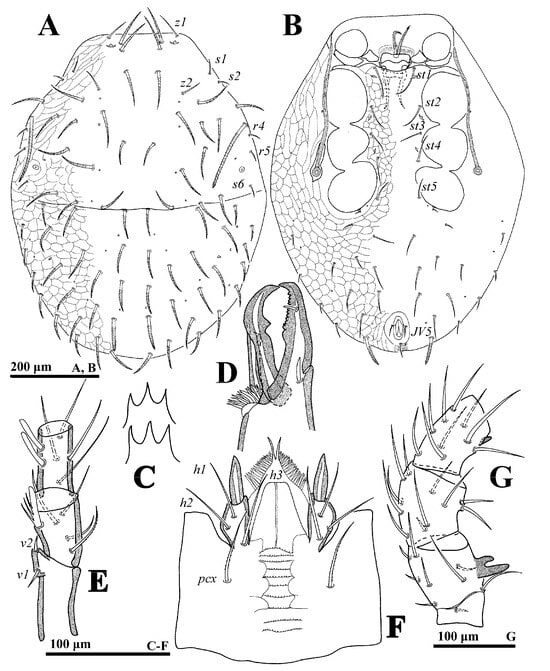
Figure 7.
Cerogamasus anhuiensis Jin & Yao sp. nov., male. (A)—Dorsal idiosoma. (B)—Ventral idiosoma. (C)—Gnathotectum. (D)—Chelicera. (E)—Subcapitulum. (F)—Trochanter, femur and genu of palp. (G)—Femur, genu and tibia of leg II.
Ventral idiosoma (Figure 7B). Tritosternum base reduced. Genital opening flanked by two pairs of presternal platelets. Lengths of setae st1–st5 on sternogenital region: st1 67–69, st2 49–54, st3 51–54, st4 45–48, st5 47–50. Ventrianal region with 14 pairs of setae, of which JV5 (48–52) stout and pilose distally. Peritrematal groove length: 207–321.
Gnathosoma (Figure 7D–F). Gnathotectum emerging from nude base. Movable digit with a blunt tooth. Palp length: 265–281; trochanter with one pointed ventral protuberance, bearing short and fine setae v1, and v2 and v2 stouter than v1. Lengths of setae: h1 58–64, h2 46–51, h3 54–56 and pcx 63–65.
Legs. Lengths of legs I–IV: 844–877, 551–623, 512–623, 790–928, respectively. Leg II obviously stouter than others. Femur II with a main spur (proximal) and an axillary process (distally); tibia II with a spur (Figure 7G).
Other stages. Unknown.
Etymology. The new species name is derived from the type locality Anhui Province, China (anhuiensis).
Differential diagnosis. C. anhuiensis sp. nov. is morphologically similar to C. tibetensis sp. nov. in the setal form with regard to dorsal shields, the number of teeth on the cheliceral and tibia II with a spur in males. However, C. anhuiensis sp. nov. female is different from C. tibetensis sp. nov. as follows: (1) opisthogastric shield bearing nine pairs of setae, vs. ten pairs in C. tibetensis sp. nov.; (2) gnathotectum emerging from denticulate base, vs. nude base in C. tibetensis sp. nov.; (3) seta v2 on palptrochanter stouter than v1, vs. seate v1 and v2 equal in size in C. tibetensis sp. nov.; (4) seta pcx on gnathosoma pilose, vs. smooth in C. tibetensis sp. nov. The differences between them in the male are as follows: (1) opisthogastric region with one pair of setae distally pilose, vs. six pairs in C. tibetensis sp. nov.; (2) genu II without spur, vs. a spur in C. tibetensis sp. nov.
3.1.3. Cerogamasus guizhouensis Jin & Yao sp. nov.
Type material. Holotype: ♀, encountered in weed pile, Tuanlong Village (1031 m a.s.l., N 27°54′52″, E 108°38′20″), Tongren, Guizhou Province, China, 1 May 2019. Paratypes: three ♀♀, same collection data as the holotype; two ♀♀, encountered in decaying leaves, Tuanlong Village (1304 m a.s.l., N 27°55′1″, E 108°38′21″), Tongren, Guizhou Province, China, May 1, 2019; one ♀ and three ♂♂ encountered in a weed pile, Tuanlong Village (1045 m a.s.l., N 27°54′5″, E 108°36′3″), Tongren, Guizhou Province, China, 2 May 2019.
Diagnosis. Both sexes: dorsal setae z1, z2, s1, s2, r4, r5 and r6 smooth; gnathotectum emerging from denticulate base; seta pcx on gnathosoma pilose; setae v1 and v2 on palptrochanter equal in size. In the female, endogynium with a saccate structure, its centre having a floriform structure; opisthogastric shield bearing ten pairs of ventral setae, of which four pair distally pilose. In the male, opisthogastric region with eight pairs of setae distally pilose; movable digit with a big blunt tooth and several small teeth; genu II and tibia II with a spur.
- Description
Female (n = 7). Dorsal idiosoma (Figure 8A). Idiosoma well sclerotized, length 735–768, width 494–548. Podonotal shield with 22 pairs of setae, of which setae z1, z2, s1, s2, r4, r5 fine and smooth, other thicked and pilose. Lengths of setae on podonotal shield: j1 62–63, j2 69–71, j3 67–70, j4 74–77, j5 52–55, j6 44–48, z1 37–40, z2 46–48, z3 59–61, z4 62–63, z5 65–67, z6 45–46, s1 27–29, s2 26–30, s3 56–58, s4 60–61, s5 60–61, s6 35–40, r2 60–62, r3 130–137, r4 17–19, r5 24–27. Seta r6 smooth and off the shield. Opisthonotal shield with 22 to 23 pairs of thicked and pilose setae, of which setae R serie shortest.
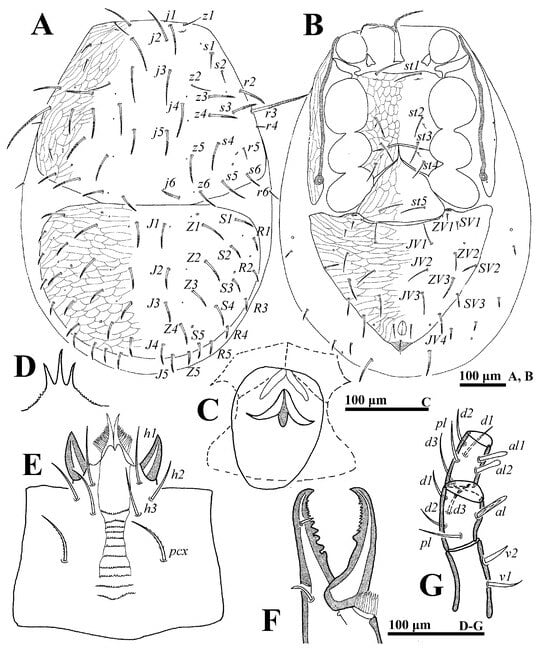
Figure 8.
Cerogamasus guizhouensis Jin & Yao sp. nov., female. (A)—Dorsal idiosoma; (B)—Ventral idiosoma; (C)—Endogynium; (D)—Gnathotectum; (E)—Subcapitulum; (F)—Chelicera; (G)—Trochanter, femur and genu of palp.
Ventral idiosoma (Figure 8B). Tritosternum flanked by one pair of presternal platelets. Sternal setae st1 (65–67) longer than st2 (48–50) and st3 (50–54). Endogynium (Figure 8C) with a saccate structure, its centre having a floriform structure. Gland pores gv2 with three openings. Opisthogastric shield bearing ten pairs of setae. Seta JV4, ZV4, SV2, SV3 distally pilose. Opisthogastric soft cuticle with five pairs of pilose setae, of which JV5 is the longest. Peritrematal groove length: 304–314. Lengths of setae on opisthogastric shield: JV1 44–46, JV2 40–44, JV3 45–46, JV4 43–45, ZV1 13–14, ZV2 43–45, ZV3 46–49, SV1 14–15, SV2 26–28, SV3 34–38, pa 21–23, po 20–22.
Gnathosoma (Figure 8D–F). Gnathotectum emerging from denticulate base. Deutosternal groove with 11 denticulate rows; setae h1 (61–63), h2 (48–52), h3 (49–54) smooth, and pcx (62–66) pilose. Fixed and movable digits of chelicera with several small teeth. Palp length: 271–281; trochanter bearing two stout setae (v1 and v2); femur with five setae, of which al pectinate, d3 sligthly pilose; genu with six pairs of setae, of which al1 and al2 entire.
Legs. Lengths of legs I–IV: 854–874, 600–622, 553–569, 823–855, respectively. Most leg setae distally pilose.
Male (n = 3). Dorsal idiosoma (Figure 9A). Idiosoma length: 683–703; width: 436–470. Holodorsal shield covering entire dorsum; a suture closely anterior to seta J1. All setae on the shield; setal form as in female.
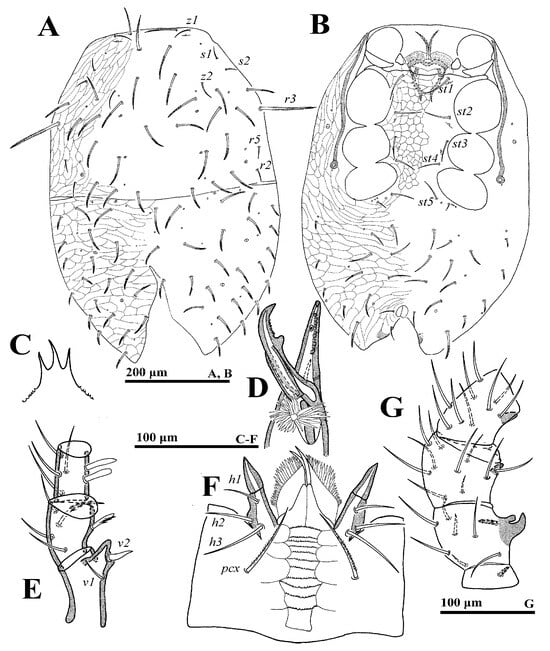
Figure 9.
Cerogamasus guizhouensis Jin & Yao sp. nov., male. (A)—Dorsal idiosoma. (B)—Ventral idiosoma. (C)—Gnathotectum. (D)—Chelicera. (E)—Trochanter, femur and genu of palp. (F)—Subcapitulum. (G)—Femur, genu and tibia of leg II.
Ventral idiosoma (Figure 9B). Tritosternum base reduced. Genital opening flanked by one pair of presternal platelets, sometimes fragmented. Lengths of setae st1–st5 on sternogenital region: st1 59–61, st2 51–53, st3 42–44, st4 39–41, st5 37–40. Opisthogastric region with 12 pairs of setae, of which 7 pairs pilose. Peritrematal groove length 287–303.
Gnathosoma (Figure 9C–F). Movable digit with a big blunt tooth and several small teeth. Palp length: 212–239; trochanter with one pointed ventral protuberance, bearing seta v2 evidently stouter, v1 near the base. Lengths of setae: h1 25–29, h2 34–39, h3 48–50 and pcx 56–59.
Legs. Lengths of legs: I: 755–799; II: 514–553; III: 469–501; IV: 728–761. Femur II with a main spur (proximal) and an axillary process (distally); genu II and tibia II with a spur (Figure 9G).
Other stages. Unknown.
Etymology. The new species name is derived from the type locality Guizhou Province (guizhouensis).
Differential diagnosis. C. guizhouensis sp. nov. is morphologically similar to C. tibetensis sp. nov. in the setal form with regard to the opisthonotal shield, the setal number on the opisthogastric shield of female and opisthogastric soft cuticle and the genu II and tibia II of male with a spur. However, C. guizhouensis sp. nov. is different from C. tibetensis sp. nov. as follows: (1) dorsal seta z2 smooth and s6 distally pilose, vs. seta z2 distally pilose and s6 smooth in C. tibetensis sp. nov.; (2) gnathotectum emerging from denticulate base, vs. nude base in C. tibetensis sp. nov.; (3) seta pcx on gnathosoma pilose, vs. smooth in C. tibetensis sp. nov. In addition, the differences between them in the female are as follows: (1) presternal platelets one pair, vs. three pairs in C. tibetensis sp. nov.; (2) opisthonotal shield with four pairs of pilose setae, vs. one pair in C. tibetensis sp. nov.; (3) seta v1 and v2 on palptrochanter stout and equal in length, vs. seta v1 slender and about twice as long as seta v2 in C. tibetensis sp. nov. The difference between them in the male is as follows: (1) opisthogastric region with eight pairs of pilose setae, vs. six pairs in C. tibetensis sp. nov.
3.1.4. Multidentatus Jin & Yao sp. nov.
Type material. Holotype: ♀, encountered in rotten wood, Tianmushan National Nature Reserve (293 m a.s.l., N: 30°19′3″, E: 119°26′36″), Hangzhou, Zhejiang Province, China, 20 July 2018. Paratypes: two ♀♀ and one ♂, same collection data as the holotype; four ♀♀ and two ♂♂ encountered in decaying leaves, Tianmushan National Nature Reserve (754 m a.s.l., N: 30°20′10″, E: 119°27′5″), Hangzhou, Zhejiang Province, China, 20 July 2018; two ♀♀ and three ♂♂ encountered in rotten wood, Mangdangshan National Nature Reserve (619 m a.s.l., N: 26°20′42″, E: 119°26′13″), Nangping, Fujian Province, China, 6 August 2018.
Diagnosis. Both sexes: dorsal setae z1, s1, s2, s6, r4, r5, R1, R2, R3 smooth; gnathotectum emerging from the nude base; seta pcx on gnathosoma smooth; setae v1 on palptrochanter longer than v2. In the female, endogynium with a saccate structure, distal with an inverted V-shaped structure, the base with several teeth, each side flanked with two lamellar structures; opisthogastric shield bearing nine pairs of ventral setae, of which four pairs are distally pilose. In the male, opisthogastric region with eight pairs of distally pilose setae; seta v2 on palptrochanter modified to button-shaped; movable digit with a big blunt; genu II and tibia II without spur.
- Description
Female (n = 9). Dorsal idiosoma (Figure 10A). Idiosoma well sclerotized; length: 760–795: width: 559–576. Podonotal shield with 22 pairs of setae, of which setae z1, s1, s2, s6, r4, r5 are fine and smooth, and others are thick and distally pilose. Lengths of setae on podonotal shield: j1 65–67, j2 75–77, j3 76–78, j4 114–118, j5 55–58, j6 75–77, z1 48–51, z2 65–68, z3 81–83, z4 83–87, z5 95–99, z6 65–67, s1 22–23, s2 20–24, s3 81–84, s4 89–92, s5 98–101, s6 19–23, r2 76–78, r3 160–165, r4 19–21, r5 22–24. Opisthonotal shield with 23 to 25 pairs of setae, of which R1, R2 and R3 are smooth, and others are distally pilose. Setae R series shortest.
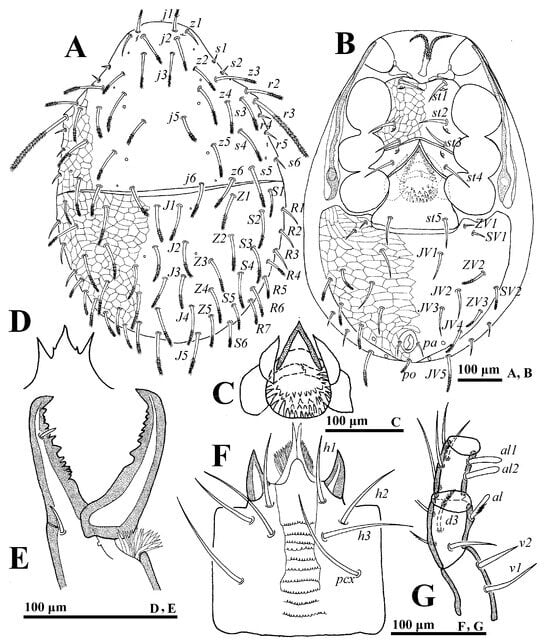
Figure 10.
Cerogamasus multidentatus Jin & Yao sp. nov., female. (A)—Dorsal idiosoma. (B)—Ventral idiosoma. (C)—Endogynium. (D)—Gnathotectum. (E)—Chelicera. (F)—Subcapitulum. (G)—Trochanter, femur and genu of palp.
Ventral idiosoma (Figure 10B). Tritosternum flanked by three pairs of presternal platelets. Sternal setae st1 (62–75) and st2 (60–62) stouter than st3 (64–67). Gland pores gv2 invisible. Endogynium with a saccate structure, distal with an inverted V-shaped structure, the base with several teeth, each side flanked with two lamellar structures (Figure 10C). Opisthogastric shield bearing nine pairs of ventral setae. Setae JV4, ZV2, ZV3, SV2 distally pilose. Opisthogastric soft cuticle with three pairs of setae, of which JV5 long (78–81) and distally pilose. Peritrematal groove length: 303–321. Lengths of setae on opisthogastric shield: JV1 61–63, JV2 62–65, JV3 65–69, JV4 65–68, JV5 85–89, ZV1 16–19, ZV2 65–67, ZV3 60–64, SV1 19–21, SV2 58–62, pa 27–29, po 22–25.
Gnathosoma (Figure 10D–F). Gnathotectum with three prongs, emerging from nude base. Fixed and movable digits of chelicera with several teeth. Deutosternal groove with ten denticulate rows; setae h1 (69–74), h2 (65–67), h3 (84–92) and pcx (76–79) smooth. Palp length: 232–261; trochanter bearing two stout setae (v1 and v2); femur with five setae (al, d1, d2, d3 and pl), of which al pectinate and d3 slightly pilose; genu with six pairs of setae (al1, al2, d1, d2, d3 and pl), of which al1 and al2 entire.
Legs. Lengths of legs I–IV: 787–860, 575–602, 617–647, 723–931, respectively. Most leg setae distally pilose.
Male (n = 3). Dorsal idiosoma (Figure 11A). Idiosoma length: 746–768; width: 532–545. Holodorsal shield covering entire dorsum; a suture closely anterior to seta J1. All setae on the shield; setal form as in female.

Figure 11.
Cerogamasus multidentatus Jin & Yao sp. nov., male. (A)—Dorsal idiosoma. (B)—Ventral idiosoma. (C)—Gnathotectum. (D)—Chelicera. (E)—Trochanter of palp. (F)—Subcapitulum. (G)—Femur, genu and tibia of leg II.
Ventral idiosoma (Figure 11B). Tritosternum base reduced. Genital opening flanked by three pairs of presternal platelets. Lengths of setae st1–st5 on sternogenital region: st1 61–68, st2 64–67, st3 57–52, st4 61–64, st5 58–62. Opisthogastric region with 13 pairs of setae, of which 3 pairs distally pilose. Peritrematal groove length: 237–299.
Gnathosoma (Figure 11D–F). Gnathotectum with four prongs. Palp length: 239–245; trochanter with one pointed ventral protuberance, bearing seta v2 button-shaped, and v1 near the base. Movable digit with a blunt tooth. Lengths of setae: h1 63–67, h2 51–60, h3 72–74 and pcx 68–71.
Legs. Lengths of legs: I 755–799, II 514–553, III 469–501, IV 728–761. Femur II with a main spur (proximal) and an axillary process (distally); genu II and tibia II without spur (Figure 11G).
Other stages. Unknown.
Etymology. This species is named after its endogynium with many teeth (multidentatus).
Differential diagnosis. C. multidentatus sp. nov. is morphologically similar to C. tibetensis sp. nov. in setal form and number on podonotal shield, the number of chelicera and presternal platelets, and to the setal form of subcapitulum. However, the differences between them in the female are as follows: (1) dorsal setae R1, R2 and R3 smooth, vs. pilose in C. tibetensis sp. nov.; (2) opisthogastric shield with nine pairs of setae, vs. ten pairs in C. tibetensis sp. nov.; (3) ventral seta ZV2, ZV3 and SV2 distally pilose, vs. smooth in C. tibetensis sp. nov.; (4) endogynium with several teeth, vs. without teeth in C. tibetensis sp. nov. The differences between them in the male are as follows: (1) opisthogastric region with three pairs of pilose setae, vs. six pairs in C. tibetensis sp. nov.; (2) gnathotectum with four prongs, vs. three prongs in C. tibetensis sp. nov.; (3) seta v2 on palptrochanter button-shaped, vs. acicular in C. tibetensis sp. nov.; (4) genu II and tibia II without spur, vs. a spur in C. tibetensis sp. nov.
3.2. Key to the Species of the Genus Cerogamasus gen. nov.
- Females
- 1.
- Opisthogastric shield with five pairs of setae; seta v2 on the palptrochanter distally pilose setae………………………..…………………………..…….C. coreanus comb. nov.
- –
- Opisthogastric shield with nine or ten pairs of setae; seta v2 on the palptrochanter smooth……………………………………….……………………………………………..2
- 2.
- Opisthogastric shield with nine pairs of setae………………………………………....3
- –
- Opisthogastric shield with ten pairs of setae…………………………………..……....4
- 3.
- Endogynium with several teeth; dorsal setae R1, R2 and R3 smooth................................................................................................C. multidentatus sp. nov.
- –
- Endogynium without teeth; dorsal setae R1, R2 and R3 pilose. C. anshunensis sp. nov.
- 4.
- Dorsal seta z2 pilose, z2 smooth; opisthogastric shield with one pair of pilose setae………………………………………………………………….….C. tibetensis sp. nov.
- –
- Dorsal seta z2 smooth, z2 pilose; opisthogastric shield with four pair of pilose setae…………………………………………………………….…C. guizhouensis sp. nov.
- Males
- 1.
- Genu II with a spur; movable digit only with a big tooth……………............................2
- –
- Genu II without spur; movable digit with a big tooth and several small teeth…........3
- 2.
- Tibia II with a spur; dorsal setae R1, R2 and R3 smooth…….. C. multidentatus sp. nov.
- –
- Tibia II without spur; dorsal setae R1, R2 and R3 pilose……….C. anshunensis sp. nov.
- 3.
- Dorsal seta z2 pilose, z2 smooth; opisthogastric shield with six pairs of pilose setae………………………………………………………...............….C. tibetensis sp. nov.
- –
- Dorsal seta z2 smooth, z2 pilose; opisthogastric shield with eight pairs of pilose setae……………………………………………………....………....C. guizhouensis sp. nov.
4. Discussion
The family Parasitidae comprises two subfamilies: Parasitinae and Pergamasinae. The generic concept of this family is not stable. The number of genera varies depending on authors and their view on the systematics of the family, especially on the rank of taxa []. The most comprehensive monograph on mites of Parasitidae contains 45 genera (23 genera within Parasitinae and 22 genera within Pergamasinae []). Juvara-Bals [] described a new genus: Occigamasus Juvara-Bals, 2019 (Pergamasinae). Makarova [] described another genus: Thalassogamasus Makarova, 2019 (Parasitinae). Yao et al. [] indicated Taiwanoparasitus Tseng, 1995, a newly synonymized with Psilogamasus. The family now contains 46 genera, Parasitinae and Pergamasinae, each with 23 genera. These genera are easily distinguished from the new genus by the female with two shields; dorsal idiosoma in both sexes bears more than 40 pairs of setae, of which fewer than 7 pairs of podonotal setae are smooth; seta z5 of dorsal hexagon similar to j5 and j6 in form (pilose or distally pilose); seta al of palpfemur pectinate, al1 and al2 of palpgenu entire; gnathotectum trispinate; female peritrematal shields posteriorly free; male palptrochanter with one pointed ventral protuberance.
The placement of the species Cycetogamasus coreanus needs some discussion. This species was previously known only from the adult females collected from litter and moist black humus in Korea []. The original description of C. coreanus is not very detailed or adequately illustrated. Recently, C. coreanus has been redescribed []. The genus Cycetogamasus was established by Athias-Henriot with Cycetogamasus diviortus Athias-Henriot, 1967, as its type species []. The main characteristics of the females of this genus are the presence of the cingulum, gland pores gv2 with one or two openings and a movable digit with three teeth. Cycetogamasus diviortus is different from those species, especially the type species C. diviortus, in the following characteristics: absence of the cingulum, many teeth on the movable digit of the chelicera and gland pores gv2 with three openings or not seen [,]. The common features of female C. coreanus with Cerogamasus gen. nov. are the following: female peritrematal shields free posteriorly; dorsal setae z5, j5 and j6 pilose or distally pilose; less than seven pairs of podonotal setae smooth; trochanter of palp with one pointed ventral protuberance in the male. We conclude that C. coreanus must be included in the new genus Cerogamasus.
Cerogamasus coreanus (Athias-Henriot) comb. nov.
Cycetogamasus coreanus Athias-Henriot, 1980: 290 []; Keum et al. 2019: 16 [].
The geographical distribution of Cerogamasus gen. nov. is currently limited to Asia, i.e., China, Republic of Korea and North Korea [,]. Because only one deutonymph was collected from the moss, we are not confident about the true habitat of the species in the genus. The apparent absence of the juveniles from the decaying leaves, weed pile or rotten wood of the adult habitat might suggest another habitat for development of juveniles [,]. If immatures also inhabit decaying leaves, moss, weed piles or rotten wood, their absence may be explained by two reasons: the collector picked up the large individuals (adults) which were easily detectable with the naked eye, or almost all immatures had already reached adulthood before the moment of sampling [,,]. The chelicerae of the species in the genus have several small teeth and look very robust, which is more suitable for crushing solid food rather than sucking fluids [,,]. Catching live individuals and rearing them in the laboratory would uncover the feeding habits of this species.
The presence of a swollen protuberance on the venter of the palptrochanter in the male may be an adaptation for optimal feeding [,]. Having most of the dorsal shield setae and leg setae relatively stout and pilose distally may give the mite an advantage to move freely among decaying leaves, moss, weed piles and rotten wood [,].
Author Contributions
Conceptualization, J.C., T.Y. and D.J.; methodology, all authors; project administration, D.J.; identification, M.Y.; original draft preparation, M.Y.; review and editing, D.J., J.C. and T.Y. All authors have read and agreed to the published version of the manuscript.
Funding
This work was supported by the National Natural Science Foundation of China (No. 31872275 and 32160118), the PhD Foundation of Anshun University (asxybsjj202211 and asxybsjj202212) and the Key Laboratory of Plants Protection Informatization for Featured and Efficient Agriculture in Central Guizhou Province (Qianjiaoji KY [2022] No. 052).
Institutional Review Board Statement
Not applicable.
Informed Consent Statement
Not applicable.
Data Availability Statement
The data presented in this study are available on request from the corresponding author.
Acknowledgments
Thanks to Bruce Halliday (CSIRO Entomology, GPO Box 1700, Canberra, Australia), who helped to review the manuscript, provided helpful comments and searched for important studies, and Dongdong Li (Institute of Entomology, Guizhou University, Guiyang, China) and Yun long (Sajin junior middle school, Xinyi, China) for their great help in specimen collection.
Conflicts of Interest
The authors declare no conflicts of interest.
References
- Krantz, G.; Walter, D. A Manual of Acarology; Texas Tech University of Press Lubbock: Lubbock, TX, USA, 2009; pp. 1–816. [Google Scholar]
- Lindquist, E.E.; Kantz, G.W.; Walter, D.E. Order Mesostigmata. In A Manual of Acarology, 3rd ed.; Krantz, G.W., Walter, D.E., Eds.; Texas Tech University Press: Lubbock, TX, USA, 2009; pp. 124–232. [Google Scholar]
- Hyatt, K.H. Mites of the subfamily Parasitinae (Mesostigmata: Parasitidae) in the British Isles. Bull. Br. Mus. Nat. Hist. 1980, 38, 237–378. [Google Scholar] [CrossRef]
- Halliday, R.B.; Walter, D.E.; Polak, M. A new species of Gamasodes Oudemans from Australia (Acari: Parasitidae). Zootaxa 2005, 1001, 17–30. [Google Scholar] [CrossRef]
- Wallace, M.M.H.; Holm, E. The seasonal abundance of phoretic predatory mites associated with dung beetles in south eastern Australia (Acari: Macrochelidae, Parasitidae). Int. J. Acarol. 1985, 11, 183–189. [Google Scholar] [CrossRef]
- Heikal, H.M. Parasitus fimetorum and Macrocheles muscaedomesticae (Acarina: Parasitidae, Macrochelidae) as natural predators of the root knot nematode, Meloidogyne javanica Treub. Egypt. J. Biol. Pest Control. 2020, 30, 1–7. [Google Scholar] [CrossRef]
- Hrúzová, K.; Fenďa, P. The family Parasitidae (Acari: Mesostigmata)-history, current problems and challenges. Acarologia 2018, 58, 25–42. [Google Scholar] [CrossRef]
- Juvara-Bals, I. Occigamasus, a new genus of pergamasine mites, with description of two new species from the west coast of North America (Parasitiformes: Gamasina: Parasitidae). Acarologia 2019, 59, 551–570. [Google Scholar] [CrossRef]
- Makarova, O.L. North Pacific versus North Atlantic: A case with species of the amphiboreal littoral mite genus Thalassogamasus gen. nov. (Parasitifomes, Mesostigmata, Parasitidae). Zootaxa 2019, 4647, 457–485. [Google Scholar] [CrossRef] [PubMed]
- Yao, M.Y.; Yi, T.C.; Jin, D.C.; Guo, J.J. A new species of Psilogamasus AthiasHenriot, 1969 from China and redefinition of the genus (Parasitiformes: Parasitidae). Acarologia 2020, 60, 1–11. [Google Scholar] [CrossRef]
- Jiang, T.M.; Guo, C.S.; Wang, F.Z. A preliminary report of mice extracorporeal gamasid mites in Sanchazi, Jilin Province. J. Jilin Med. Univ. 1963, 2, 327–328. (In Chinese) [Google Scholar]
- Pan, Z.W.; Deng, G.P. Economic Entomology of China, Volume 17 (Acari, Gamasina); Science Press: Beijing, China, 1980; pp. 139–140. (In Chinese) [Google Scholar]
- Ma, L.M. New species of subfamily Parasitinae from north Qing-Zang Plateau, China. I. Genera Parasitus and Cornigamasus (Acarina: Parasitidae). Acta Zootaxonomica Sin. 1986, 11, 379–388. (In Chinese) [Google Scholar]
- Gu, Y.M.; Wang, J.S.; Yang, X.Z.; Li, F.H. Mites of the subfamily Parasitidae in China with descriptions of three new species (Acarina: Parasitidae). Acta Zootaxonomica Sin. 1987, 12, 40–48. (In Chinese) [Google Scholar]
- Ma, L.M. New species of subfamily Parasitinae from north Qing-Zang Plateau, China. II. Genera Vulgarogamasus (Acarina: Parasitidae). Acta Zootaxonomica Sin. 1987, 12, 271–285. (In Chinese) [Google Scholar]
- Ma, L.M. Descriptions of a new species and an unknown male of Gamasodes from north Qing-Zang Plateau (Acari: Mesostigmata, Parasitidae). Acta Entomol. Sin. 1992, 35, 113–116. (In Chinese) [Google Scholar]
- Gu, Y.M.; Liu, J.O. A new species of the genus Gamasodes from China (Acari: Parasitidae). Acta Zootaxonomica Sin. 1995, 20, 65–67. (In Chinese) [Google Scholar]
- Tseng, Y.H. A taxonomically study of free living Gamasine mite family Parasitidae Oudemans (Acari, Mesostigmata) from Taiwan. J. Taiwan Mus. 1995, 48, 11–81. [Google Scholar]
- Ma, L.M.; Wang, S.R. Four new species of the family Parasitidae and discovery of the genus Trachygamausus in China (Acari: Mesostigmata). Zhuxing Xuebao 1996, 5, 81–88. [Google Scholar]
- Ma, L.M.; Lin, J.Z. Four new species of the family Parasitidae (Acari, Gamasina). Acta Zootaxonomica Sin. 2005, 21, 76–82. (In Chinese) [Google Scholar]
- Ma, L.M.; Lin, J.Z.; Zhang, Y.X. A new species of Parasitus and a new species of Vulgarogamasus (Acari: Mesostigmata: Parasitidae). Acta Arachnol. Sin. 2008, 17, 2–5. [Google Scholar]
- Ma, L. Six species of the family Parasitinae known supplemental descriptions (Acari: Gamasina). Zhuxuing Xuebao 2010, 1, 20–25. [Google Scholar]
- Ma, L.M.; Bai, X.L. A new species of the genus Parasitus and a new species of the genus Gamasodes (Acari: Mesostigmata: Parasitidae). Acta Arachnol. Sin. 2012, 21, 76–82. (In Chinese) [Google Scholar]
- Bai, X.L.; Ma, L.M. A new species of the genus Vulgarogamasus and the supplementary description of female of Neogamasus Crispus Ma & Yan (Acari, Parasitidae). Acta Zootaxonomica Sin. 2013, 38, 70–74. (In Chinese) [Google Scholar]
- Yao, M.Y.; Yi, T.C.; Guo, J.J.; Jin, D.C.; Zhang, R.Z. Three new species of Trachygamasus (Mesostigmata: Parasitidae) from China, with a key to world species of the genus. Syst. Appl. Acarol. 2019, 24, 1465–1489. [Google Scholar] [CrossRef]
- Yao, M.Y.; Long, Y.; Yi, T.C.; Guo, J.J.; Jin, D.C.; Zhang, R.Z. Description of two new species of Trachygamasus Berlese (Mesostigmata: Parasitidae) and the male of Trachygamasus multisetus from China, with notes on the genus. Syst. Appl. Acarol. 2020, 25, 633–648. [Google Scholar] [CrossRef]
- Yao, M.Y.; Chen, J.X.; Yi, T.C.; Jin, D.C. A new species of Meriadenogamasus Athias-Henriot (Parasitiformes: Parasitidae) from China, with a key to world species of the genus. Syst. Appl. Acarol. 2022, 27, 45–52. [Google Scholar] [CrossRef]
- Evans, G.O. Some observations on the chaetotaxy of the pedipalps in the Mesostigmata (Acari). J. Nat. Hist. 1963, 6, 513–527. [Google Scholar] [CrossRef]
- Athias-Henriot, C. La divergence néotaxique des Gamasides (Arachnides). Bull. Sci. Bourgogne 1971, 28, 93–106. [Google Scholar]
- Athias-Henriot, C. Nouvelles notes sur les Amblyseiini II. Le relevé organotaxique de la face dorsaleadulte (Gamasides, Protoadenique, Phytoseiidae). Acarologia 1975, 17, 20–29. [Google Scholar]
- Athias-Henriot, C. Psilogamasus hurlbutti, n. g., n. sp., gamaside nouveau de Tanzani (Acariens Anactinotriches, Parasitidae). In Annales de la Société entomologique de France; Taylor & Francis: Abingdon, UK, 1969; Volume 5, pp. 439–449. [Google Scholar]
- Athias-Henriot, C. Parasitidae nord-coréens (Parasitiformes): Apparentés au genre Neogamasus Tikh., avec création de trois nouvaux genres. Ann. Hist.-Nat. Mus. Nat. Hung. 1980, 72, 285–294. [Google Scholar]
- Keum, E.; Kaczmarek, S.; Marquardt, T.; Jung, C. First Records of Genera Cycetogamasus and Neogamasus of Parasitidae (Parasitiformes: Mesostigmata) from the Republic of Korea. Korean J. Appl. Entomol. 2019, 58, 15–25. [Google Scholar] [CrossRef]
- Al-Atawi, F.; Klompen, H.; Moser, J.C. Redescription of Schizosthetus lyriformis (McGraw and Farrier, 1969) (Parasitiformes: Parasitidae), with revision of the genus. Int. J. Acarol. 2002, 28, 341–360. [Google Scholar] [CrossRef]
- Mašán, P.; Halliday, B. Ochaechulla spinturniciformis, a new genus and species of mite in the family Laelapidae (Acari: Mesostigmata) from Slovakia. Acarologia 2024, 64, 697–710. [Google Scholar] [CrossRef]
- Faraji, F.; Zare, M.; Rahmani, H. A new genus and species of Digamasellidae (Acari: Mesostigmata) displaying some extraordinary gnathosomal structures. Acarologia 2021, 61, 967–977. [Google Scholar] [CrossRef]
- de Lillo, E.; Di Palma, A.; Nuzzaci, G. Morphological adaptations of mite chelicerae to different trophic activities (Acari). Entomologica 2001, 35, 125–180. [Google Scholar]
- Buryn, R.; Brandl, R. Are the morphometrics of chelicerae correlated with diet in mesostigmatid mites (Acari). Exp. Appl. Acarol. 1992, 14, 67–82. [Google Scholar] [CrossRef]
- Sabelis, M.W.; Bakker, F.M. How predatory mites cope with the web of their tetranychid prey: A functional view on dorsal chaetotaxy in the Phytoseiidae. Exp. Appl. Acarol. 1992, 16, 203–225. [Google Scholar] [CrossRef]
- Di Palma, A.; Kitajima, E.W.; Lofego, A.C. The extravagantly modified dorsal setae of Daidalotarsonemus oliveirai and Excelsotarsonemus caravelis (Acari: Prostigmata: Tarsonemidae) females: Ultrastructure and functional implications. Arthropod. Struct. Dev. 2021, 63, 101057. [Google Scholar] [CrossRef]
Disclaimer/Publisher’s Note: The statements, opinions and data contained in all publications are solely those of the individual author(s) and contributor(s) and not of MDPI and/or the editor(s). MDPI and/or the editor(s) disclaim responsibility for any injury to people or property resulting from any ideas, methods, instructions or products referred to in the content. |
© 2024 by the authors. Licensee MDPI, Basel, Switzerland. This article is an open access article distributed under the terms and conditions of the Creative Commons Attribution (CC BY) license (https://creativecommons.org/licenses/by/4.0/).